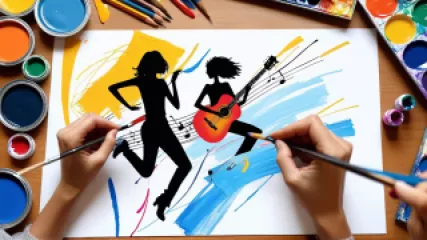Research Summary on Effective Expressive Arts Therapy Techniques
Expressive arts therapy is a multifaceted and dynamic approach to mental health treatment that integrates various art forms such as painting, drawing, music, dance, and drama. This therapeutic method offers a unique avenue for self-expression, emotional release, and self-discovery. In this research summary, we will delve into the effectiveness of different expressive arts therapy techniques, examining their impact on individuals' mental and emotional well-being.
The Foundation of Expressive Arts Therapy
Expressive arts therapy is founded on the belief that engaging in creative processes can foster healing and personal growth. The therapy combines elements from various artistic disciplines, allowing individuals to explore their inner world through multiple modalities. Unlike traditional talk therapy, expressive arts therapy emphasizes non-verbal communication, making it accessible to people who might find verbal expression challenging.
Theoretical Underpinnings
Several theories underpin expressive arts therapy, including:
- Psychoanalytic Theory: This theory suggests that art can serve as a means of accessing the unconscious mind, enabling individuals to uncover hidden thoughts and emotions.
- Humanistic Theory: Emphasizing personal growth and self-actualization, humanistic theory aligns with expressive arts therapy's focus on self-discovery and holistic well-being.
- Gestalt Theory: Gestalt theory's emphasis on awareness and present-moment experience complements the experiential nature of expressive arts therapy.
Techniques in Expressive Arts Therapy
Various techniques are employed in expressive arts therapy to facilitate self-expression and emotional processing. Some of these techniques include:
Art Therapy
Art therapy involves using visual arts like painting, drawing, and sculpting to express emotions and experiences. Research has shown that art therapy can help individuals process trauma, reduce anxiety, and improve self-esteem.
"Art therapy effectively reduces symptoms of depression and anxiety by providing a non-verbal outlet for emotional expression."Journal of Art Therapy
Music Therapy
Music therapy utilizes music to address emotional, cognitive, and social needs. Techniques such as songwriting, improvisation, and listening to music can enhance mood, reduce stress, and improve communication skills.
- Receptive Music Therapy: Involves listening to music selected by the therapist to evoke specific emotions or memories.
- Active Music Therapy: Includes activities like playing instruments, singing, or composing music, encouraging active participation and creativity.
Dance/Movement Therapy
Dance/movement therapy uses body movement to promote emotional, cognitive, and physical integration. This technique can be particularly effective for individuals who have difficulty expressing themselves verbally.
"Dance/movement therapy provides a safe space for individuals to explore and express their emotions through bodily movements."International Journal of Dance Therapy
Drama Therapy
Drama therapy involves using role-playing, storytelling, and theatrical techniques to explore emotions and experiences. It can help individuals gain new perspectives, develop empathy, and enhance problem-solving skills.
- Role-Playing: Allows individuals to explore different aspects of their personality and rehearse new behaviors in a safe environment.
- Storytelling: Encourages individuals to narrate their experiences, fostering a sense of coherence and meaning.
Research Findings on Expressive Arts Therapy
Numerous studies have investigated the effectiveness of expressive arts therapy techniques in various populations. Here, we summarize some key findings:
Expressive Arts Therapy for Trauma Recovery
Trauma can have profound and long-lasting effects on an individual's mental health. Expressive arts therapy has been shown to be a valuable tool in trauma recovery by providing a safe space for individuals to process and integrate traumatic experiences.
"Expressive arts therapy helps trauma survivors externalize their experiences, facilitating emotional processing and reducing symptoms of post-traumatic stress disorder (PTSD)."Journal of Trauma & Dissociation
Benefits for Anxiety and Depression
Anxiety and depression are common mental health conditions that can significantly impact an individual's quality of life. Research indicates that expressive arts therapy can alleviate symptoms of anxiety and depression by promoting relaxation, enhancing self-esteem, and providing a means of self-expression.
- A study found that art therapy significantly reduced anxiety levels in patients with chronic illnesses.
- Music therapy has been shown to improve mood and reduce depressive symptoms in older adults.
Enhancing Self-Esteem and Self-Discovery
Expressive arts therapy can play a crucial role in enhancing self-esteem and fostering self-discovery. By engaging in creative processes, individuals can gain insights into their identity, strengths, and values.
"Engaging in expressive arts therapy allows individuals to explore and affirm their unique identity, leading to improved self-esteem and a deeper understanding of themselves."Journal of Humanistic Psychology
Case Studies: Real-Life Applications of Expressive Arts Therapy
To illustrate the practical applications of expressive arts therapy, we present several case studies highlighting its impact on individuals with diverse backgrounds and therapeutic needs.
Case Study 1: Overcoming Childhood Trauma through Art Therapy
Isabel Bell, a 10-year-old girl, experienced significant trauma due to domestic violence. Traditional talk therapy proved challenging for Isabel, as she struggled to articulate her feelings verbally. Her therapist introduced art therapy as an alternative approach.
"Through drawing and painting, Isabel was able to express her fears and emotions. Over time, her artwork became a powerful tool for communication and healing."Isabel's Therapist
Art therapy allowed Isabel to externalize her trauma, leading to reduced anxiety and improved emotional regulation. Her therapist noted a marked improvement in Isabel's overall well-being and resilience.
Case Study 2: Alleviating Anxiety through Music Therapy
Cornelius Mitchell, a 45-year-old man, struggled with severe anxiety that affected his daily life. He found it difficult to relax and often felt overwhelmed by stress. His therapist recommended music therapy as a complementary treatment.
"Cornelius participated in receptive music therapy sessions, where he listened to calming music selected by his therapist. The music helped him relax and provided a sense of comfort and safety."Cornelius's Therapist
Over several months, Cornelius's anxiety levels decreased significantly. He reported feeling more at ease and better equipped to manage stress. Music therapy became an integral part of his self-care routine.
Integrating Expressive Arts Therapy into Clinical Practice
Integrating expressive arts therapy into clinical practice requires a thoughtful approach that considers the unique needs and preferences of each individual. Here are some guidelines for therapists looking to incorporate expressive arts therapy techniques into their practice:
Assessment and Evaluation
Before introducing expressive arts therapy, it is essential to conduct a thorough assessment of the individual's needs, strengths, and therapeutic goals. This assessment will help determine the most appropriate art forms and techniques to use.
- Consider the individual's comfort level with different art forms.
- Identify any potential barriers to participation, such as physical limitations or cultural factors.
Creating a Safe and Supportive Environment
A safe and supportive environment is crucial for the success of expressive arts therapy. Therapists should ensure that the therapy space is welcoming, non-judgmental, and conducive to creative expression.
"Creating a safe space allows individuals to feel comfortable exploring their emotions and expressing themselves authentically."Journal of Creative Arts Therapies
Encouraging Exploration and Experimentation
Expressive arts therapy encourages individuals to explore and experiment with different art forms. Therapists should provide opportunities for clients to try various techniques and mediums, fostering a sense of curiosity and playfulness.
- Offer a variety of art supplies and materials.
- Encourage clients to experiment with different styles and approaches.
The Future of Expressive Arts Therapy
The field of expressive arts therapy continues to evolve, with ongoing research and innovation shaping its future. Emerging trends and technologies offer new possibilities for enhancing the effectiveness and accessibility of expressive arts therapy.
Digital Art Therapy
Advancements in digital technology have opened up new avenues for creative expression. Digital art therapy utilizes tools such as tablets, graphic design software, and virtual reality to engage individuals in the creative process.
"Digital art therapy provides a versatile and accessible platform for self-expression, allowing individuals to explore their creativity in new and innovative ways."Journal of Digital Art Therapy
Telehealth and Online Therapy
The rise of telehealth has expanded access to expressive arts therapy, enabling individuals to participate in therapy sessions remotely. Online platforms and virtual therapy rooms provide opportunities for creative engagement and therapeutic support.
- Telehealth can reach individuals in remote or underserved areas.
- Online therapy sessions can be tailored to include various expressive arts techniques.
Conclusion
Expressive arts therapy offers a powerful and versatile approach to mental health treatment, harnessing the transformative power of creative expression. By incorporating various art forms, this therapy provides a unique avenue for self-expression, emotional release, and self-discovery. Research has demonstrated the effectiveness of expressive arts therapy techniques in addressing a wide range of mental health issues, from trauma recovery to anxiety and depression.
As the field continues to grow and evolve, it is essential for therapists to remain informed about emerging trends and best practices. By integrating expressive arts therapy into clinical practice, therapists can offer individuals a rich and multifaceted therapeutic experience, fostering healing, personal growth, and enhanced well-being.
Ultimately, expressive arts therapy reminds us of the profound connection between creativity and healing, inspiring us to embrace the transformative power of the arts in our journey toward mental and emotional wellness.






